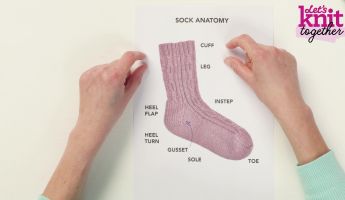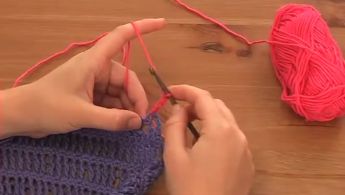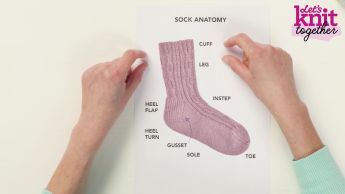How To Insert a Lifeline
video by
Neti Love & Julie Peasgood
- Overview
- Practical Guides
When working a complicated pattern, or even just a large piece of knitting, if you make a mistake that you can’t easily fix you’ll be glad you can insert a lifeline to save you from having to start again from scratch.
This lifeline is especially useful when working a textured pattern or lacy pattern. It is all too easy to work a row out of sequence or simply lose track in a pattern repeat, and where there are several different stitches to negotiate it can be tricky to work back across to the row correctly to get to an error.
Likewise, if you realise you have dropped stitch a stitch and have to work back up several rows in a varied pattern, it can be hard to work out what to do on each row to keep the overall pattern correct.
The solution is to insert a lifeline along a correct row so that, if needed, you can frog (rip it, rip it!) back your work to the lifeline, re-insert your knitting needle through all the stitches with ease and restart from that correct row. This is usually best done after the end of a correct pattern repeat or key stage in the pattern. When you have successfully completed the next repeat or stage, you can pull out the lifeline and reinsert it if needed.
All you need is a tapestry needle threaded with a length of smooth contrast yarn that is thinner than your project yarn and roughly 10cm longer than your row.
TIP If you get into the habit of inserting a lifeline after a set number of rows each time, you’ll only ever need to undo those few rows to restart your knitting.
After a row where you want to insert the lifeline, insert the tapestry needle and yarn through the stitches on the knitting needle. Use the knitting needle itself as a guide and pull the fabric down slightly to insert the tapestry needle through every stitch loop on the knitting needle. If there are any stitch markers, do not thread the lifeline through these, as they are meant to move up the knitting.
Take care not to split the yarn of stitches as you work as if you need to use this lifeline, you may reinsert the knitting needle incorrectly, and it also makes it more difficult to remove the lifeline.
Once the lifeline is fully inserted check that you have caught all of the stitches, then work your next row or round being careful not to work the lifeline as part of the stitches.
If you need to use the lifeline, remove your needle and pull back your work to the lifeline row. Carefully feed the tip of the knitting needle from one end and follow the lifeline through each stitch exactly, without splitting or twisting any stitches along the way. Aim to work from the end opposite the working yarn to end up with the needle tip at the end with the working yarn, or simply slip the stitches across to another needle to be ready to work.
TIP You can use a narrower needle at this point if easier, as the stitches have already been formed, but be sure to work onto your project needles at the next row.
As you know which row you are back to, count the number of stitches to ensure that you will be starting the next row with the correct number and you have not accidentally missed any when reinserting your knitting needle.
Keep the lifeline in place until you can insert it higher up; remove it by simply pulling on one end. It should come out fairly easily, unless caught in a split stitch or it has been accidentally worked into the knitting, use fine scissors handy to cut the lifeline without snipping into any of your knitted stitches.
Honeycomb stitch sample pattern
Using chunky yarn and 6mm needles, cast on 12 sts.
Row 1 (set up row): sl1 pwise, rep (k1, yo, sl1 pwise) to last st, p1. Turn.
Row 2 WS: sl1 pwise, [k2tog, yo, sl 1 pwise] to last st, p1. Turn.
Row 3 RS: sl1 pwise, k1, [sl yo pwise, KNIT 2] to last 2 sts, k1, p1 Turn.
Row 4 WS: sl1 pwise, [yo, sl1 pwise, k2tog] to last st, p1. Turn.
Row 5 RS: sl1 pwise, [KNIT 2, sl yo purlwise] to last st, p1 Turn.
Repeat Rows 2-5 to continue the pattern.
Cast off in Row 2 pattern after a Row 5.











































